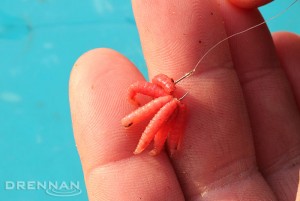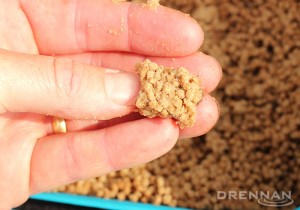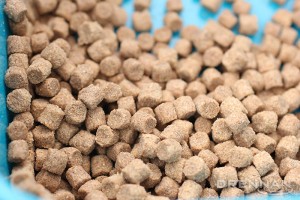Match-ace Dean Barlow explains his top baits for commercial fisheries at this time of year:
 CASTERS – I love casters for shallow fishing. A nice steady stream of casters falling through the layers is perfect for catching F1s and big carp alike.
CASTERS – I love casters for shallow fishing. A nice steady stream of casters falling through the layers is perfect for catching F1s and big carp alike.
I usually start by feeding a dozen or so casters with a catty. As the fish start competing confidently or if you get bothered by small silverfish I would up the feed to double that amount. The key is to keep feeding constantly.
Single caster is best for F1s while a bunch of dead maggots falling down amongst the casters can sort the better carp out. Keep changing depths to locate where the feeding fish are happiest. Once you find that catching zone a really big weight can be had on this method.
For a 5-hour session 4 pints is ample and I personally like my casters to be all different shades, even with a few just-turned white ones in there.
 CHOPPED WORM – When fed with casters, chopped worm is one of my favourite combinations. With the fish coming out of winter mode they’ll be looking to pack on the weight quickly and when the fish are hungry and active there’s often nothing that can touch this method.
CHOPPED WORM – When fed with casters, chopped worm is one of my favourite combinations. With the fish coming out of winter mode they’ll be looking to pack on the weight quickly and when the fish are hungry and active there’s often nothing that can touch this method.
If I am fishing chopped worm and caster in shallow water, such as the far side of a snake lake, I like my worms to be chopped pretty fine so it’s almost a mush. You can also try mixing this mush with a fine fishmeal groundbait like Bait-Tech Karma. I overwet the groundbait so it makes a heavy cloud as it hits the water from the pole pot. If the venue is pretty clear I will also add some black dye or fine soil to the mix to help create a darker cloud.
For fishing in deeper water I won’t chop my worms so fine. This helps the bait to stay on the bottom. The bigger pieces will also help to attract better fish. I might also add a little corn to help keep the fish on the bottom and bulk the mix out.
Hook baits can range from a tiny worm head to a whole worm – or ‘dangler’ as I call it! Generally, I try and fish what I’m feeding, so if I’m on the mush I will fish with small pieces on the hook. Likewise I use bigger hook baits when feeding bigger pieces. A kilo of worms with a couple pf pints of casters and a tin of corn should last you a couple of sessions for this kind of fishing. You’ll also catch every kind of fish on this bait combo.
MEAT – A great warm weather bait that accounts for some really big match weights of carp. I like to fish meat on what we call the ‘5m line’ which generally means at the bottom of the near ledge.
I prefer to feed 6mm sized cubes of meat by hand on a regular basis. I will often also feed some hemp with the meat, which helps to keep the fish on the bottom.
I like to fish an 8mm piece on the hook so it stands out amongst the loose offerings. I might also have some hookbaits dyed red and yellow. These stand out even more and can be picked out easily by the fish.
Your tackle will have to be strong as when the fish turn up on this line it’s definitely game on! A stable and strong float is needed as I will be lifting and dropping the rig regularly to imitate the loose feed. My number one choice is the Drennan Carp 2 tied to 0.18mm main line with 0.16mm hooklength and a size 14 Kamasan B911 X-Strong hook.
 DEAD MAGGOTS – The perfect margin bait, often accompanied by groundbait if it’s allowed. With the water warming up the fish will be looking for shallow water. I will look to fish in about 18 inches of water to start with, but if I start missing bites or foul hooking fish I wouldn’t hesitate to move up the ledge into only 10 inches of water. Feeding heavily with varying ratios of dead maggots and groundbait can accounts for some really big weights.
DEAD MAGGOTS – The perfect margin bait, often accompanied by groundbait if it’s allowed. With the water warming up the fish will be looking for shallow water. I will look to fish in about 18 inches of water to start with, but if I start missing bites or foul hooking fish I wouldn’t hesitate to move up the ledge into only 10 inches of water. Feeding heavily with varying ratios of dead maggots and groundbait can accounts for some really big weights.
I freeze my maggots to kill them and when I get to my peg I put them in a tub of water to defrost them. This also helps them keep their colour. Three pints is plenty for your day’s fishing.
Strong line and hooks are needed for this. My choice is a 0.18mm hooklength with a size 12 Margin Carp hook onto which I wouldn’t hesitate to impale 7 or 8 maggots.
Fish don’t tend to venture into the margins until later in the day so I don’t feed down the edge until around two hours into the session. Leaving the margins unfed until this time really seems to help you get the best rewards from this area.
 MICRO PELLETS – I prepare my 2mm micro pellets when I get to my peg by filling a 1.1pt Drennan tub with dry pellets, right to the top. I then add water until the tub is full. I then put the lid on and leave it while I carry on setting up. The amount of water is just enough to fill the gaps in the tub. When you’re ready, take the lid off and the pellets will be like a soft, expanded block. Tip them into a larger tub and fluff them up with your fingers to separate them. The result should be perfect, spongy micros that you can use for both the Method feeder or pole fishing.
MICRO PELLETS – I prepare my 2mm micro pellets when I get to my peg by filling a 1.1pt Drennan tub with dry pellets, right to the top. I then add water until the tub is full. I then put the lid on and leave it while I carry on setting up. The amount of water is just enough to fill the gaps in the tub. When you’re ready, take the lid off and the pellets will be like a soft, expanded block. Tip them into a larger tub and fluff them up with your fingers to separate them. The result should be perfect, spongy micros that you can use for both the Method feeder or pole fishing.
Micros can be really good for feeding across in shallow water on snake-type lakes fed little and often through a small pot. Combine it with a 4mm expander or soft hook pellet to get the best results.
For venues that are too wide for pole fishing there’s nothing better to mould around a Method feeder than micro pellets. I often also have a small amount of groundbait mixed up and if I’m fishing for F1s and small carp I will use a 50/50 mix of micros and groundbait.
Cast regularly to attract fish into the swim and use a 6mm hard pellet as a good starting bait, with mini boilies and dead maggots a good change hook bait. On harder venues I would also try dying my micros yellow as sometime these little changes can make all the difference.
 HARD PELLETS – Dry coarse pellets straight from the bag can be fed and fished on the pole or waggler. Personally, I love pellet waggler fishing. You don’t need to be firing pouches of pellets every time to get the best out of this method; little and often is the best approach by far.
HARD PELLETS – Dry coarse pellets straight from the bag can be fed and fished on the pole or waggler. Personally, I love pellet waggler fishing. You don’t need to be firing pouches of pellets every time to get the best out of this method; little and often is the best approach by far.
I will start a session by only feeding 5 or 6 pellets. At long range 8mm pellets are best and 6mm for a shorter distance. The noise of the pellets landing will attract the inquisitive fish.
I like to use a Crystal Pellet Waggler which is less visible in the water. Strong gear is needed, so I load my reel with 5lb Feeder & Method Mono and my hooklegths are usually 0.18mm with a hair-rigged latex band tied to a size 14 Carp Feeder hook.
 Start the session by catapulting a
Start the session by catapulting a
couple of times then cast just past the baited area. This usually gets a response straight away as the noise of the waggler and hook bait landing will hopefully attract the fish. If this doesn’t happen I will draw the float closer, over the baited area and feed again. The rig needs only be in the water for a minute before recasting and repeating.
Depthwise I would usually start about 2ft deep. If no bites I would deepen the rig 6in at a time to find the depth the fish are feeding at. Likewise, I will shallow up the rig small amounts if I start regular;ly missing bites or foul hooking fish.
This method is very busy and repetitive and it can really pay dividends to keep feeding and casting and persevering with it.


